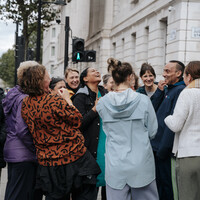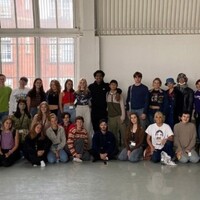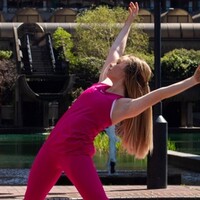MA Screendance student Margo Roe on studying at LCDS

News Story
With more and more TV shows and films incorporating contemporary dance, we sat down with MA Screendance student and filmmaker Margo Roe to explore the changing landscape of film and how screendance can be a powerful medium to explore current social issues.
Q: What made you join the MA Screendance course and what have you gained whilst being here?
A: After completing my BA in Dance and Drama at Lincoln University and working as a filmmaker for over six years, I decided to do an MA and have the space to critically reflect on my filmmaking, which is something I've always wanted to do. I’d known of the MA Screendance course since it began in 2018 and was aware that it is the only postgraduate degree of its kind. Although I hadn’t engaged with London Contemporary Dance School before beginning my postgraduate degree, I was familiar with the school and its leading reputation.
Q: What motivates your work?
A: I realised quite early on in my career that I wanted to create film work that involved movement. I’ve been making commissioned films since around 2016, and movement is one of the key forms of language.
What I am interested in is movement that comes from within a character – movement that isn’t necessarily technique-based. I’m very invested in how movement can be the driving force in a film, where it is part of the world and not a subject matter.
These interests have really fed into my film work. My BFI Midlands Short film POP which was created in 2019 and explores the idea of masculinity in the Midlands rural working class, a culture that I know.
As well as sitting alongside and reinforcing my interest in screendance, the film highlights another motivation of mine which is social issues such as class and regionality. For this reason, a lot of my ideas are social commentary-based, specifically looking at working class communities. POP is one such example.
Opportunities such as Frame Rush, the student led LCDS screendance event, are great for seeing international work and understanding how screendance and film is exhibited through festivals.
Margo Roe
Q: Your most recent film Searching for Cowardice combines dialogue and movement. How is movement part of the driving concept?
A: My short film Searching for Cowardice – which was created as part of the BBC New Creatives programme and broadcast as part of BBC4’s Female Filmmakers screening – is set in an alternate time where five teenagers are trying to live in a time of world war and navigate their next steps. After the success of BBC New Creatives, it is now being adapted as a TV series with funding from the BFI Young Audience Content Fund.
The movement in Searching for Cowardice is very character driven. It’s not so much about technique; in this film, movement is an extension of what a character is trying to communicate, whether that may be the smallest of everyday gestures to an explosion of feeling.
Q: Do you face any cross-disciplinary challenges? Are there any barriers in terms of the film industry’s understanding of what movement is?
A: It is really encouraging to see that movement is being brought into mainstream TV shows, including the likes of the BBC series Giri / Haji that has an entire dance scene choreographed by Liam Steel. Or the US season one finale of Euphoria, that again ends with a choreographed dance to the original song by Zendaya “All of Us”.
However, when it comes to doing film funding applications, there are some barriers in terms of general misunderstandings about what movement is. This is partly because people from a non-dance background understand it from their point of reference, and that the point of reference may be Billy Elliott or other musicals. It’s almost about changing the moulds of how we share things or apply for this type of funding. I have found that videos and supporting visual material is being optioned more readily within application processed. This means we can put a face behind the writing and incorporate visuals, movement and other notions that might be hard to explain via the written word. What I do find interesting it the divide of Arts Council Funding and BFI/ Film Funding and trying to figure out where screendance and movement on film fits within the two.
Q: What advice would you give to people interested in doing MA Screendance?
A: If you want to learn about filmmaking or are a dancer interested in making movement on film, this is the course for you. Before applying, look at the alumni, course and teachers. Ask yourself what you want from it and how it’ll help with professional development.
Opportunities such as Frame Rush, the student led LCDS screendance event, are great for seeing international work and understanding how screendance and film is exhibited through festivals. What’s more, the course lecturers are leading researchers and practitioners in the art form so – you get real access to people that are in the screendance industry.


